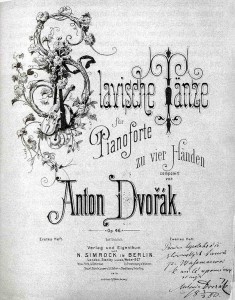Dvořák: Slavonic Dance, Op. 72, No. 2
 If you’re familiar with Dvořák’s Slavonic Dances, you probably know the orchestral version. But both sets, Op. 46 and Op. 72, were originally written for piano four hands and later orchestrated by Dvořák.
If you’re familiar with Dvořák’s Slavonic Dances, you probably know the orchestral version. But both sets, Op. 46 and Op. 72, were originally written for piano four hands and later orchestrated by Dvořák.
Piano four hands means, as you might expect, one piano and two players. It became a popular genre in the days before the gramophone and after the time that the piano was extended to its current range of 7+ octaves. Pianos before Beethoven’s time (1770-1827) normally had keyboards of only 5 octaves. It wasn’t just that a shorter keyboard afforded less room for four hands to maneuver; the smaller range also meant there was less reason to bring in four hands to exploit the possibilities.
Four hands made a lot of sense in the mid 19th century, however. Pianos had the range we know today along with iron frames and, consequently, a much bigger sound. Music still had to be made in order to be heard. There was no button to push or gramophone to wind up. Many large-scale works such as symphonies could be better played in four-hand arrangements than by solo piano, and publishers put out arrangements to meet the demand. It all fit well in an age when people commonly made music in their home.
And there was the social factor. A couple could sit side by side with their hands brushing against each other as they pursued a common goal. Yes, times were different.
Dvořák’s first set of Slavonic Dances (Op. 46) caught the attention of Johannes Brahms and also Brahms’ publisher Fritz Simrock. Simrock published both the piano and orchestral versions, and Dvořák sprang to success. The second set (Op. 72) followed some eight years later with similar success.



